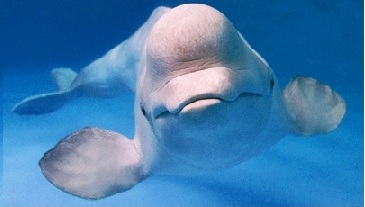You’ve heard of whales singing, but what about talking? If that sounds crazy, most marine biologists would have agreed until they had heard it — a whale trying to imitate human speech. In fact, they had not realized it was physically possible for whales to make those kinds of sounds until a beluga whale named NOC spoke up.
Whales do not imitate human speech the way parrots do, but scientific reports dating to the 1970s mentioned whales vocalizing in “garbled” human-like voices. Yet no one had ever recorded these sounds or confirmed they came from whales. Then a diver at the National Marine Mammal Foundation in San Diego surfaced near a whale enclosure asking, “Who told me to get out?”
 A beluga whale, the same species as NOC. Credit: premier.gov.ru
A beluga whale, the same species as NOC. Credit: premier.gov.ruThe diver and his colleagues traced the human-like speech he had heard to a beluga whale named NOC, whose vocalizations they eventually recorded and studied. They found that NOC’s “speech” had frequencies close to that of human speech (200—300 Hz) but a few octaves below typical whale songs.
The difference resulted from how NOC made the sounds. While humans make sounds through their larynx, beluga whales sing by changing pressure in their nasal cavities as air passes through a valve near their blowhole known as the phonic lips. But NOC was doing something else. He was inflating a pouch in his blowhole called a vestibular sac, while also changing nasal cavity pressure and adjusting muscles near his phonic lips. So NOC appeared to be making an extra effort to produce the more human-like sounds he had heard from his keepers.
NOC has since passed away, and scientists cannot say why NOC or other whales might attempt to imitate human speech. But they are at least one step closer to understanding how these communicative creatures manage to do it.


